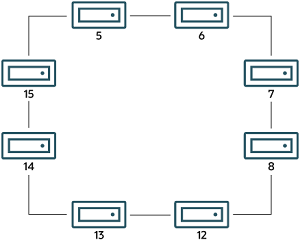The membership table describes the view that
each data node has of all the others in the cluster, including
node group membership, president node, arbitrator, arbitrator
successor, arbitrator connection states, and other information.
The membership table contains the following
columns:
node_idThis node's node ID
group_idNode group to which this node belongs
left nodeNode ID of the previous node
right_nodeNode ID of the next node
presidentPresident's node ID
successorNode ID of successor to president
succession_orderOrder in which this node succeeds to presidency
Conf_HB_order-
arbitratorNode ID of arbitrator
arb_ticketInternal identifier used to track arbitration
arb_stateArbitration state
arb_connectedWhether this node is connected to the arbitrator; either of
YesorNoconnected_rank1_arbsConnected arbitrators of rank 1
connected_rank2_arbsConnected arbitrators of rank 1
Notes
The node ID and node group ID are the same as reported by ndb_mgm -e "SHOW".
left_node and right_node
are defined in terms of a model that connects all data nodes in
a circle, in order of their node IDs, similar to the ordering of
the numbers on a clock dial, as shown here:
In this example, we have 8 data nodes, numbered 5, 6, 7, 8, 12, 13, 14, and 15, ordered clockwise in a circle. We determine “left” and “right” from the interior of the circle. The node to the left of node 5 is node 15, and the node to the right of node 5 is node 6. You can see all these relationships by running the following query and observing the output:
mysql> SELECT node_id,left_node,right_node
-> FROM ndbinfo.membership;
+---------+-----------+------------+
| node_id | left_node | right_node |
+---------+-----------+------------+
| 5 | 15 | 6 |
| 6 | 5 | 7 |
| 7 | 6 | 8 |
| 8 | 7 | 12 |
| 12 | 8 | 13 |
| 13 | 12 | 14 |
| 14 | 13 | 15 |
| 15 | 14 | 5 |
+---------+-----------+------------+
8 rows in set (0.00 sec)The designations “left” and “right” are used in the event log in the same way.
The president node is the node viewed by the
current node as responsible for setting an arbitrator (see
NDB Cluster Start Phases). If the president
fails or becomes disconnected, the current node expects the node
whose ID is shown in the successor column to
become the new president. The
succession_order column shows the place in
the succession queue that the current node views itself as
having.
In a normal NDB Cluster, all data nodes should see the same node
as president, and the same node (other than
the president) as its successor. In addition,
the current president should see itself as 1
in the order of succession, the successor
node should see itself as 2, and so on.
All nodes should show the same arb_ticket
values as well as the same arb_state values.
Possible arb_state values are
ARBIT_NULL, ARBIT_INIT,
ARBIT_FIND, ARBIT_PREP1,
ARBIT_PREP2, ARBIT_START,
ARBIT_RUN, ARBIT_CHOOSE,
ARBIT_CRASH, and UNKNOWN.
arb_connected shows whether this node is
connected to the node shown as this node's
arbitrator.
The connected_rank1_arbs and
connected_rank2_arbs columns each display a
list of 0 or more arbitrators having an
ArbitrationRank equal to
1, or to 2, respectively.
Both management nodes and API nodes are eligible to become arbitrators.
